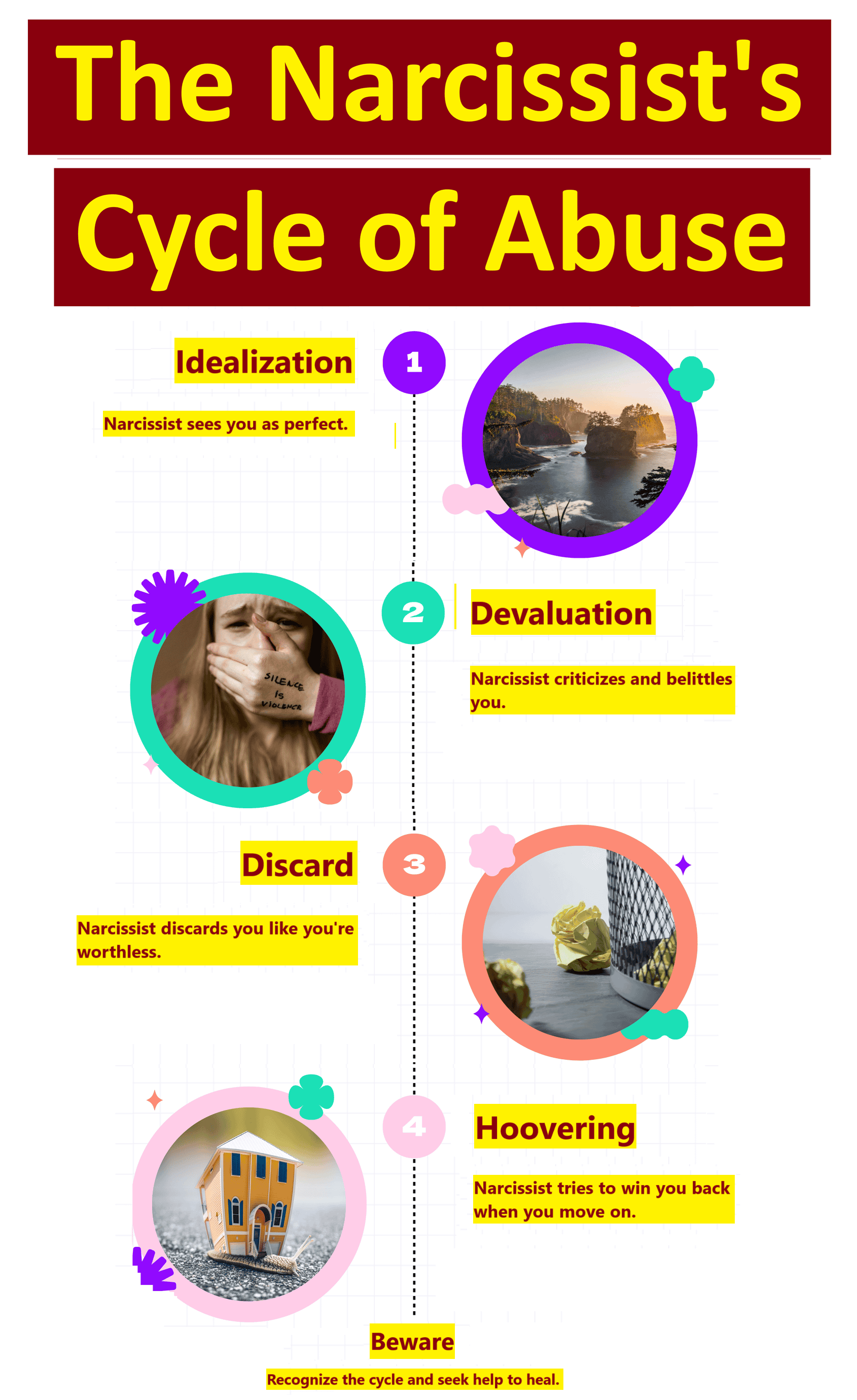Relationships with narcissists often follow a specific pattern: idealization, devaluation, and discard. In the idealization phase, the narcissist showers you with affection, making you feel like the center of their universe. This creates an intense, seemingly perfect connection.
Eventually, the devaluation phase begins. The narcissist starts to find faults, criticize, and manipulate you. The initial affection fades, replaced by control and emotional abuse, as the narcissist’s fragile ego leads to constant put-downs and blame-shifting.
At final stage, the discard phase occurs, where the narcissist abruptly or gradually abandons the relationship. This often leaves you feeling worthless and confused as the narcissist moves on, seeking new sources of admiration without regard for the emotional damage left behind.
6 Stages a Narcissist Goes Through After a Break-Up
Stage 1: Denial
Denial typically characterizes the initial response of a narcissist after a break-up. Narcissists often refuse to accept that the relationship is over.
They might downplay the significance of the split or convince themselves it’s temporary. Denial serves as a psychological shield, protecting their fragile ego from the reality of loss.
Stage 2: Anger
Anger usually follows once denial starts to wane. Narcissists often direct rage towards their ex-partner, blaming them entirely for the break-up.
This anger can manifest through vindictive behavior, such as spreading rumors or attempting to sabotage their ex’s new relationships. Unchecked anger highlights their inability to process rejection healthily.
Stage 3: Bargaining
In the bargaining stage, narcissists might attempt to regain control. They can make false promises or claim they’ve changed to lure their ex-partner back.
This stage is marked by manipulation, where they exploit emotional vulnerabilities. It’s a tactical move to maintain dominance and validation.
Stage 4: Depression
Depression may set in if bargaining fails. Narcissists might experience profound sadness and emptiness. Unlike typical depression, their sadness is less about missing the ex-partner and more about the narcissistic injury—feeling unworthy and unloved.
This stage can involve isolating themselves or engaging in self-destructive behavior.
Stage 5: Acceptance and Rebuilding
In acceptance and rebuilding, narcissists begin to move on, though this acceptance is often superficial. They might seek new sources of validation through new relationships or achievements.
This rebuilding phase focuses on re-establishing their sense of superiority and masking any lingering feelings of loss.
Stage 6: Returning to Old Patterns
Returning to old patterns signifies a full-circle moment. Narcissists tend to revert to their previous behaviors, resuming their pursuit of admiration and control in new relationships. They often seek out new individuals to fill the void left by the break-up, ensuring a constant supply of validation and attention.
By understanding these six stages, you can better navigate the complexities surrounding a break-up with a narcissist.
After Effects of a Break-Up on a Narcissist
Impact on Self-Image and Behavior
After a break-up, a narcissist experiences a severe blow to their self-image. The break-up threatens their idealized self-view. They often resort to blaming the ex-partner to protect their ego.
You might notice increased arrogance and hostility as they seek to assert dominance and control over their narrative.
In terms of behavior, they likely indulge in attention-seeking actions, such as posting provocative content online or flaunting new relationships.
This behavior serves as a coping mechanism, aimed at regaining the admiration they crave. They might engage in smear campaigns against their ex, portraying themselves as the victim.
Long-Term Psychological Effects
Long-term, the impact of a break-up on a narcissist includes chronic feelings of emptiness and worthlessness. Despite outward appearances, they struggle internally. Their inability to process emotions healthily can lead to prolonged states of depression and anxiety.
A narcissist might cycle through relationships rapidly, searching for a new source of validation. This cycle often prevents them from forming meaningful, lasting connections. Over time, their relationships become increasingly superficial, marked by a persistent need for praise and control.
Coping Mechanisms for Those Affected by Narcissists
Strategies for Self-Care and Recovery
Focusing on self-care and recovery after a break-up with a narcissist ensures you’re equipped to regain control of your life. Prioritizing these strategies helps mitigate the emotional toll inflicted by the relationship.
- Engage in Therapy
Professional support can provide valuable insights and coping mechanisms. Engage in sessions with a licensed therapist specializing in narcissistic abuse. - Establish a Routine
Consistent daily schedules foster a sense of stability and normalcy. Make sure to include activities you enjoy and find relaxing. - Practice Mindfulness
Mindfulness techniques like meditation and deep-breathing exercises reduce stress and promote calm. Use apps or attend classes to enhance your practice. - Exercise Regularly
Physical activity improves both mental and physical health. Engage in exercises such as running, yoga, or even walking to boost your mood and energy levels. - Maintain a Healthy Diet
Balanced nutrition supports overall well-being. Avoid excessive caffeine and sugar, and increase your intake of fruits, vegetables, and proteins. - Journal Your Feelings
Writing down thoughts and emotions serves as an emotional outlet. Regular journaling helps you process feelings and identify patterns in your behavior and reactions.
Setting Boundaries and Seeking Support
Setting firm boundaries and seeking external support are crucial for your protection and healing. These actions help create a safe environment, free from further manipulation.
- Establish Clear Boundaries
Clearly define what behaviors are unacceptable and communicate these to those around you. Consistently enforce these boundaries to maintain your well-being. - Limit Contact
Minimize or eliminate communication with the narcissist. Avoid engaging in arguments or explanations, and if necessary, consider using a third party for essential communications. - Seek Social Support
Surround yourself with friends and family who understand your situation. Their empathy and support provide a reassuring presence and can help amplify your emotional strength. - Join Support Groups
Online or in-person support groups offer shared experiences and advice. Connecting with others who’ve undergone similar experiences provides solidarity and reassurance. - Educate Yourself
Understanding narcissistic behaviors and the impacts of narcissistic abuse empowers you. Read articles, books, and resources to gain deeper insights. - Legal Protection Measures
If the narcissist exhibits threatening behavior, legal protection may be necessary. Consult with legal professionals about restraining orders or other protective measures.
Final Thoughts
Navigating a breakup with a narcissist can be incredibly challenging, but understanding their behavior and its impact on you is the first step toward recovery.
By focusing on self-care and implementing strategies like therapy, mindfulness, and setting boundaries, you can regain control over your life.
It’s essential to prioritize your well-being and seek support from trusted friends, family, or support groups.
Remember, healing is a journey, and taking proactive steps will help you protect yourself from further manipulation and move forward with confidence.





